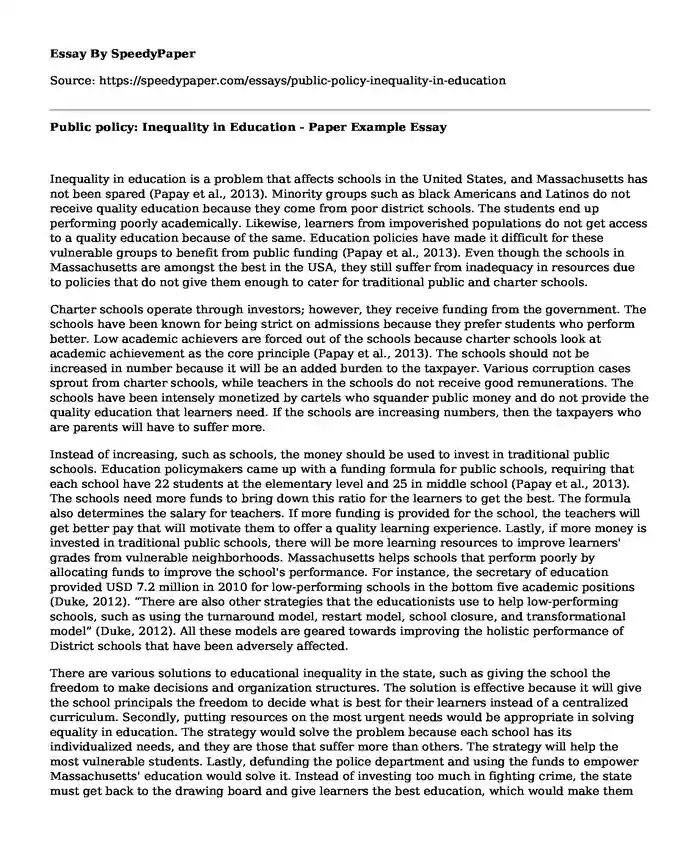Inequality in education is a problem that affects schools in the United States, and Massachusetts has not been spared (Papay et al., 2013). Minority groups such as black Americans and Latinos do not receive quality education because they come from poor district schools. The students end up performing poorly academically. Likewise, learners from impoverished populations do not get access to a quality education because of the same. Education policies have made it difficult for these vulnerable groups to benefit from public funding (Papay et al., 2013). Even though the schools in Massachusetts are amongst the best in the USA, they still suffer from inadequacy in resources due to policies that do not give them enough to cater for traditional public and charter schools.
Charter schools operate through investors; however, they receive funding from the government. The schools have been known for being strict on admissions because they prefer students who perform better. Low academic achievers are forced out of the schools because charter schools look at academic achievement as the core principle (Papay et al., 2013). The schools should not be increased in number because it will be an added burden to the taxpayer. Various corruption cases sprout from charter schools, while teachers in the schools do not receive good remunerations. The schools have been intensely monetized by cartels who squander public money and do not provide the quality education that learners need. If the schools are increasing numbers, then the taxpayers who are parents will have to suffer more.
Instead of increasing, such as schools, the money should be used to invest in traditional public schools. Education policymakers came up with a funding formula for public schools, requiring that each school have 22 students at the elementary level and 25 in middle school (Papay et al., 2013). The schools need more funds to bring down this ratio for the learners to get the best. The formula also determines the salary for teachers. If more funding is provided for the school, the teachers will get better pay that will motivate them to offer a quality learning experience. Lastly, if more money is invested in traditional public schools, there will be more learning resources to improve learners' grades from vulnerable neighborhoods. Massachusetts helps schools that perform poorly by allocating funds to improve the school's performance. For instance, the secretary of education provided USD 7.2 million in 2010 for low-performing schools in the bottom five academic positions (Duke, 2012). “There are also other strategies that the educationists use to help low-performing schools, such as using the turnaround model, restart model, school closure, and transformational model” (Duke, 2012). All these models are geared towards improving the holistic performance of District schools that have been adversely affected.
There are various solutions to educational inequality in the state, such as giving the school the freedom to make decisions and organization structures. The solution is effective because it will give the school principals the freedom to decide what is best for their learners instead of a centralized curriculum. Secondly, putting resources on the most urgent needs would be appropriate in solving equality in education. The strategy would solve the problem because each school has its individualized needs, and they are those that suffer more than others. The strategy will help the most vulnerable students. Lastly, defunding the police department and using the funds to empower Massachusetts' education would solve it. Instead of investing too much in fighting crime, the state must get back to the drawing board and give learners the best education, which would make them responsible citizens in the future. The best proactive way to fight crime is by investing in education. Therefore, the best solution to curb inequality in schools is to reassess the police budget and set the money aside to invest in poorly performing schools in Massachusetts.
References
Duke, D. L. (2012). Tinkering and turnarounds: Understanding the contemporary campaign to improve low-performing schools. Journal of Education for Students Placed at Risk (JESPAR), 17(1-2), 9-24. https://doi.org/10.1080/10824669.2012.636696
Papay, J. P., Murnane, R. J., & Willett, J. B. (2013). Inequality and Educational Attainment: Evidence from Massachusetts. Society for Research on Educational Effectiveness. https://doi.org/10.3102%2F0162373715576364
Cite this page
Public policy: Inequality in Education - Paper Example. (2023, Dec 28). Retrieved from https://speedypaper.net/essays/public-policy-inequality-in-education
Request Removal
If you are the original author of this essay and no longer wish to have it published on the SpeedyPaper website, please click below to request its removal:
- Free Essay on How to Force Yourself to Study Seriously
- Admission Essay Sample: University of Pennsylvania Writing Supplement
- Knowledge Management Personal Statement Example
- Taking Care of Immigrants' Kids - Education Essay Example
- Essay Example on Patient Safety and Risk Management
- Post-Drug Approval Process. Paper Example
- Kobe Bryant's Dear Basketball: An Emotional Farewell - Essay Sample
Popular categories





